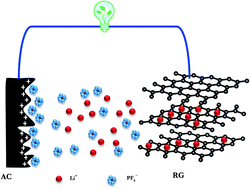Achieving high-energy dual carbon Li-ion capacitors with unique low- and high-temperature performance from spent Li-ion batteries†
Abstract
Graphite, an ordered layered structure, has been the dominant choice as a stable electrode material since the commercialization of lithium-ion batteries (LIBs), which could bring about a significant increase in demand for the material owing to its usage in forthcoming graphite-based energy storage devices. In this work, we propose an efficient route to reutilize recovered graphite (RG) from spent LIBs as an anode material for the fabrication of lithium-ion capacitors (LICs) after the required treatment. It was found that RG displayed a first excellent performance in a half-cell configuration, which further encouraged us to assemble a full cell using activated carbon as the cathode. Prior to the fabrication of the LIC, the RG was pre-lithiated (LiC6) to form a graphite intercalation compound to supply Li ions. The resultant dual-carbon LIC in an aprotic organic solvent delivered a maximum energy density of 185.54 W h kg−1 at a power density of 0.319 kW kg−1 at ambient conditions. Furthermore, different temperature performance analysis revealed that the assembled LIC presented a good cycling performance for a continuous 2000 cycles with ∼75% capacity retention at 10 °C and 25 °C. The developed dual carbon-based LIC using recovered RG from spent LIBs offers several promising features, such as low cost and good applicability in a wide range of temperature operations as well as providing a real solution to recycle the upcoming massive quantity of spent LIBs generated by different electronic appliances.



 Please wait while we load your content...
Please wait while we load your content...